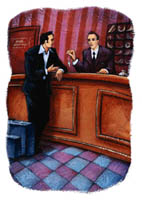What makes some companies so much better at managing customer relationships than their competitors?
Put a different way, how are companies like Enterprise Rent-A-Car, Pioneer Hi-bred Seeds, Fidelity Investments, Lexus, Intuit, and Capital One able to stay more closely connected to customers than their rivals, in ways that significantly influence these companies’ profitability?
It’s a question that formed the basis of a survey that Wharton marketing professor George Day sent to senior managers in 342 medium- to large-sized businesses from the manufacturing, transportation, public utilities, wholesale and retail trade, finance, insurance and real estate sectors. Day also conducted in-depth interviews with managers at 14 companies within the 342-firm sample, including Dow Chemical, Verizon Information Systems, GE Aircraft Engines and Ford.
The results of these surveys and interviews appear in Day’s latest research paper entitled, “Winning the Competition for Customer Relationships”, which will appear in the Sloan Management Review’s spring issue. The paper, among other things, suggests three distinct approaches to customer relationship management (CRM), each with dramatically different results.
The first approach, Day says, is the market-driven one, which makes CRM a core element of a strategy that focuses on delivering superior customer value through such elements as exceptional service and a willingness to cater to individual requirements.
Day cites Fidelity Investments’ decision to invest in understanding and segmenting its customers as an example. In 1997, he says, the company switched from a “product-centered orientation, which meant pushing only their own funds and treating all customers the same way,” toward a relational orientation “based on tailored education and investment recommendations.” This included such things as expanding their offerings to include non-Fidelity funds and presenting investment recommendations tailored to each investor’s needs.
What made the strategy “come alive,” says Day, was Fidelity’s ability to “vary the value proposition in systematic ways within each of 17 customer segments,” which in turn were based on four larger customer groupings. These included the high value segment (with large complex portfolios that needed “hand-holding”); core customers (interested in investing but not actively involved in it); active traders (interested in “top-notch execution” of their trades), and institutions and small businesses offering retirement plans for employees.
The second approach identified by Day’s survey is based on inner-directed initiatives aimed at better organizing internal data to cut service costs, help sales staff close deals faster and better target marketing activities – tasks that are usually assigned to the information technology group and have little connection to competitive strategy.
CRM technology is frequently a focus of this approach, and indeed, CRM software programs remain the fastest growing area in customer management. But Day contends that CRM technology has been oversold, noting recent studies suggesting that close to 20% of CRM initiatives “actually make things worse … Suppose you have a system (for handling customer service) that has grown up over many years and that everybody understands. If you migrate over to a sophisticated CRM system that is hard to install, contains numerous software glitches, relies on people who aren’t properly trained for the program, and lacks the necessary data to operate, then the level of service is going to go down.”
According to Day, the odds of disappointment with the inner-directed approach “are high, because the primary motivation is to solve the company’s problems, not to offer better value to customers.”
The third approach Day identifies uses defensive actions – such as loyalty programs based on redeeming points in a frequent-flyer or frequent-buyer program – designed to deny an advantage to a competitor. While “there is little chance of gaining an advantage, this type of approach at least maintains the status quo,” Day says.
One Size Doesn’t Fit All
Day’s research led him to conclude that superior performance comes from integrating three components of the customer-relating capability: an organizational orientation that makes “customer retention a priority and gives employees wide latitude to satisfy customers,” information about relationships, including the quality of relevant customer data and the systems for sharing this information across the firm; and configuration – the alignment of the organization toward building customer relationships, achieved through incentives, metrics, organization structure and accountabilities.
In looking at the whole sample of 342 firms, Day says he was surprised to find that what most separates the good firms from the bad is their configuration. “Going into this study, I would not have expected configuration to have made such a huge difference,” he notes.
Yet in looking at the 18% of the sample that are the relationship leaders, what sets them apart is their orientation, says Day. The emphasis all throughout these companies is on “customer retention. Everybody is concerned about it, not just the marketing group or the sales group. Everybody makes it a priority. Closely allied to that is an openness to sharing information about customers – rather than an ‘I own the customer and won’t share information about him or her’ attitude – and an organization-wide willingness to treat different customers differently, rather than a one-size-fits-all approach.”
Another unexpected result, Day says, was that his broad conclusions held up in all types of markets, whether B2B or B2C. “The argument has always been that in a B2B firm you have fewer customers, you know them better, they are more valuable, and so forth. But at the competitive level, it seems factors such as orientation and configuration transcend some of the industry differences.”
The ‘Red Queen’ Syndrome
Day’s research allows him to weave company examples throughout his paper in order to illustrate the different elements of a good customer relationship strategy. Under a section on orientation, for example, he writes that many companies only give “lip service to the notion that different customers should be treated differently, based on their long-run value.” He credits IBM under CEO Lou Gerstner for insisting the company take on only the best customers – and then “doing everything possible to cater to their needs,” adding that this approach saved IBM from “the worst of the problems that H-P, Cisco and Compaq encountered by chasing every Internet start-up without regard to their long-run ability to pay.”
In discussing configuration, Day points out that “relatively few businesses [in his survey] emphasized customer satisfaction and retention in their incentives. Over half gave them no emphasis at all.” Siebel Systems, the leader in CRM software, however, “is obsessively focused on customer satisfaction,” tying 50% of management’s incentive compensation and 25% of salespeople’s compensation to measures of customer satisfaction. This compensation, Day adds, is “only paid a year after the sales contract has been signed and the level of satisfaction with their performance is known.”
Superior configurations also have organization structures “that ensure the customer has a seamless interaction with the company, rather than ‘seeing’ several companies because different functional groups do not know about their other interactions,” Day writes.
The real payoff, he suggests, is when all the elements of a configuration – metrics, incentives and structures – are properly aligned, as occurred in the General Electric Aircraft Engine Business Group’s attempts to improve service for their jet engine customers. The company studied in depth what customers wanted in terms of responsiveness, reliability, value added and help in improving their productivity. Their findings led to such changes as assigning a corporate vice president to each of the top 50 customers in order to build the relationship, putting leaders of the company’s Six-Sigma quality program on site with customers, using the Internet to personalize the delivery of parts, and incorporating customer service metrics into employee evaluation criteria.
The third component of the customer-relating capability – information – is less important than orientation and configuration in distinguishing leaders from followers, Day notes. “Yet when we asked [companies] how their time and money were being allocated for building the capability, almost everything was being spent on databases, software and data mining. The rationales were ‘this is the easiest area to compare to competitors … we have to match what our competitors are doing … software vendors keep bringing us new solutions to our database management problems,” etc.
In short, Day concludes, “big investments in CRM technology are yielding negligible competitive advantages. It is the classic ‘Red Queen’ syndrome; although they are going faster and faster, they stay in the same place.”
Customer Defection Rate
One of the reasons many CRM failures occur is because companies concentrate on the customer contact processes without making corresponding changes in internal structures and systems, says Day, who cautions firms to “change the configuration before installing CRM.”
For example, while creating incentives that emphasize customer retention is smart strategy, a company should first establish the customer defection rate and how that compares with competitors’ rates. Also, it’s important to know why customers are defecting: Is it because of service, quality issues or delivery problems? Are the defectors attracted by a competitor or consciously polygamous, i.e. used to shopping around. Companies need a portfolio of metrics that “collectively reveal the long-term profitability of the customers,” which suggests looking at such measures as cost to acquire and serve or share of wallet, and at such areas as employee retention and number of customer complaints.
In addition, when considering organization structures, companies with a superior customer-relating capability were more likely than others to be organized by customer group or segment. Indeed, “49% of those saying there was clear accountability for customers’ welfare were organized by customer groups and processes versus 2% for functional.” An example, says Day, is Nokia’s decision to “split its $21 billion mobile-phone unit into nine customer units, each with its own product R&D, marketing and P&L responsibility. One unit will serve business users, while another will focus on barebones handsets for users in developing countries.”
Day suggests, however, that this model is not always appropriate. It works best, for example, when there are distinct segments or when customers want a bundle of products and services. Microsoft, he writes in his paper, tried to organize around different types of customers to get product-development groups closer to customers, but the effort “came undone because decisions about wide-utility products such as Windows were spread across too many of the new divisions.”
Day also makes the point that successful relationship managers are always “calibrating their successes against those of their competitors. In the sophisticated financial services industry, for example, Fidelity, Schwab and Merrill are all highly competent. But Fidelity and Schwab have an edge … because of their orientation. At Merrill, for example, the sales rep or account manager owns the customer” which suggests less openness about sharing information with others in the organization.
Two Case Studies
What differentiates his study from others, according to Day, is that nobody before has looked at whether being a relationship leader gives companies a competitive advantage, and by extension, significantly influences their profitability. “Companies that make relationship management a central part of their strategy are going to be the ones that win,” he says.
Attached to his paper is a comparison of the strategies of two credit card companies, Capital One and First USA. Day shows how different approaches to customer data and customer responsiveness have led Capital One to “consistently outperform First USA; it earns 40% more interest income from each customer, with double the profit margin.”
First USA, for example, “gives little consideration to differences between customers in credit risk or potential profitability,” Day notes. Its thrust, according to the former chairman, was “to be laser focused on operating efficiency and pass those savings on to customers.”
Yet this “efficiency bias,” Day says, “contributed to a self-centered orientation that doesn’t see customers as individuals … and has led to some notably wrong-footed decisions.” In mid-1999, for example, the company eliminated “the grace period for late payments while raising late fees … Customers departed in droves and the bank was forced to rescind the move.”
In addition, because First USA grew by “acquiring customer portfolios from other credit card companies, or by using third parties to source potential relationships with associations,” more distance was put “between them and their customers and prevented them from building data warehouses to hold the rich customer information that is the raw material of the customer-relating capability,” Day says.
The configuration of First USA “also gets in the way,” Day adds. The company is hierarchically organized around products or functions “like operations, collections and systems … No one has responsibility for customer retention … Front line contact employees can’t be rewarded for keeping valuable customers. Instead they try to retain everyone – whether they are bad, good or indifferent.”
Contrast this to Capital One where the goal is “to deliver the right product, at the right price, to the right customer, at the right time.” Customer responsiveness, Day says, “is deeply embedded in the organization. Their orientation is fundamentally shaped by the belief that micro-segmentation of their customers is the only way to identify and keep those who are most valuable. One result is that employees at all levels have implicit permission to act as customer advocates and take initiatives to solve customer problems.”
Day also describes the company’s “unsurpassed ability to handle customer information,” including a system where computers access the full history of a customer who calls in, cross references it with data about how millions of customers behave, and then routes the call – along with about two dozen pieces of information about the caller – to a company representative. “Suppose a customer calls to cancel his or her card. The Intelligent Call Routing system immediately displays three counter-offers, from 12.9% to 9.9%. The representative has the power to negotiate the new arrangements and is eligible for a bonus depending on the outcome of the negotiation,” Day writes in his paper.
In addition, “the U.S. card business within Capital One is structured by market segment groups such as Prime, Medium Response, Partnerships, Affinity and so forth, and then further divided at the individual business manager level where profit responsibility resides.” Instead of a cumbersome top-down organization, “Capitol One is adroit at sensing opportunities from the bottom-up, and motivated to pursue them fast.”
Day also considers the example of Canadian Pacific Hotels, noting the hotel chain’s ability to combine “deep customer insights with configuration changes” designed to increase customer loyalty in an extremely competitive market. Initially, Day says, the chain was “not well regarded by business travelers, a notoriously demanding and diverse group to serve, but also very lucrative and much coveted by other hotel chains.” Yet “by investing time and money in learning what would most satisfy this segment, the company discovered “what [these customers] mostly wanted was recognition of their individual preferences and lots of flexibility on when to arrive and check out.”
CP Hotels “mapped each step of the guest experience from check-in … to check-out, and set a standard of performance for each activity. Then it looked to what had to be done to meet a commitment it had made to personalized service.” Even small additions, such as free local calls or gift shop discounts, “required significant changes in information systems.” Along the way, the management structure was revamped so that “each hotel had a champion with broad, cross-functional ability” to ensure the hotel lived up to its ambitious goals.
After implementing these and other changes, Day writes, CP Hotels of Canadian business travel jumped by 16% in a flat market, without adding any new properties.
“Firms that sustain their commitment this way,” he concludes, “send a signal to both employees and customers that their customer-relating capability is one of the centerpieces of their strategy.”



